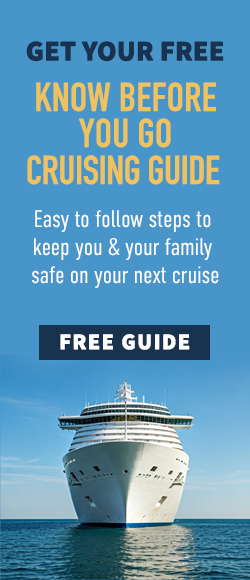November 13, 2014
D.M. v. NCL (Bahamas) Ltd.
D.M.,
Plaintiff,
v.
NCL (BAHAMAS) LTD.,
Defendant.
/
PLAINTIFF’S REPLY IN FURTHER SUPPORT OF PLAINTIFF’S MOTION FOR SUMMARY JUDGMENT
The Plaintiff, D.M., by and through undersigned counsel, hereby files his reply in further support of his Motion for Summary Judgment against Defendant, NCL (BAHAMAS), LTD. (“NCL”) [D.E. 28], and in furtherance thereof, the Plaintiff states as follows:
The Plaintiff moved for summary judgment against NCL based on the undisputed facts that 1) a heighted duty of care approaching strict liability is applied to ship owners like NCL on tender cases; and, 2) the crewmembers who were responsible for providing passengers instructions and assisting passengers (like the Plaintiff) embark and disembark the ship’s tender did not in fact provide the Plaintiff any instructions or assistance on the date of the subject incident.
In response, NCL argues that it only had a duty to exercise “ordinary” care under the circumstances and that it did not have a duty to provide warning or instruction. As set forth below, however, both of these arguments fail, as they are contrary to well established maritime law as well as NCL’s own policies and procedures.
1. Duty of Care
NCL’s argument that it only owed a duty to exercise ordinary care is contrary to Eleventh Circuit precedent. Specifically, the Eleventh Circuit has made clear that ordinary care is only applied to cases where “the menace is one commonly encountered on land and not clearly linked to nautical adventure.” Keefe v. Bahama Cruise Line, Inc., 867 F.2d 1318, 1322 (11th Cir. 1989) (emphasis added); see also Wilkinson v. Carnival Cruise Lines, Inc., 920 F.2d 1560, 1564 n. 10 (11th Cir. 1991). Herein, it is undisputed that the Plaintiff’s case did not occur on land and is in fact linked to a nautical adventure (i.e., tendering). The duty of ordinary care is therefore not applicable.
Moreover, even NCL concedes that the degree of care is established according to the “circumstances” of the incident. The Eleventh Circuit in Keefe established the sliding scale for “circumstances” as the more a situation is unique to maritime travel and/or involves danger to a passenger, the higher the ship owner’s duty. Keefe, 867 F.2d at 1322 (“[t]he extent to which circumstances surrounding maritime travel are different from those encountered in daily life and involve more danger to the passenger, will determine how high a degree of care is reasonable in each case”). Thus, tendering is subject to the highest degree of care because by its very definition, it requires the use of boats, and it is wholly unique to maritime and the cruising experience.
Further to this point, the cases NCL cites applying an ordinary duty of care[1] are easily distinguishable because none of them involve tendering operations. And under Keefe, the unique dangers associated with tendering triggers a ship owner’s heightened duty of care akin to strict liability. Indeed, the potential danger involved in the process of embarking/disembarking tenders is self-evident considering that passengers are onboard a small vessel (the tender), boarding another vessel (the cruise ship), using a gangway. Meanwhile, the two vessels and the gangway are all moving in varying directions and at varying speeds according to the weather, the sea conditions and their varying sizes.
Thus, based on the fact that tendering is inherently a maritime activity with unique dangers, NCL’s duty of care was so high that it was akin to strict liability – not ordinary care.
2. Duty to Provide Warning or Instruction
This argument, however, is equally unpersuasive for several reasons.
First, NCL had a heightened duty (as discussed above) and its own policy and procedure required crewmembers to provide assistance and warn passengers to “watch their step” as they embark or disembark the ship’s tender. [D.E. 28-1, Page 15, Lines 1-19; Page 21, Lines 1-18; Page 40, Lines 12-21; Page 51, Line 19 – Page 55, Line 4; see also D.E. 28-5, ¶¶16-17].
In Tittle v. Aldacosta, 544 F.2d 752 (5th Cir. 1977), the Former Fifth Circuit held that a crewmember’s failure to follow the owner’s procedure for disembarkation was evidence of the owner’s negligence. The Court stated:
Owner had established a procedure under which the mate was to place a towel on the transom to provide a non-skid surface for persons embarking and disembarking by stepping on the transom….
But the fact remains that the mate did not put down the towel as instructed…. On his own industry-wide self-imposed standard of care, we cannot accept… the conclusion that the absence of the precautionary towel was not negligent or a substantial contributory cause.
Tittle, 544 F.2d at 754-56 (internal citation omitted) (emphasis added).
Herein, like Tittle, it is undisputed that NCL also had an “industry-wide self-imposed standard of care,” which required its crewmembers to provide assistance and warn passengers to “watch their step” as they embarked or disembarked the ship’s tender. It is important to note that in its response, NCL never takes the position that its crewmembers did in fact assist, instruct and/or warn the Plaintiff on the date of the incident.[2] Instead, NCL merely claims that it did not need to provide warning or instruction. It is therefore also undisputed that the crewmembers near the gangway aboard the tender did not assist, instruct, or warn passengers on the date of the Plaintiff’s incident, as required under NCL’s policy and procedure. Furthermore, the Plaintiff unequivocally stated that he would have been able to step up onto the gangway if the crewmembers had stopped him and directed his attention to the edge of the gangway. [D.E. 28-2, Page 158, Lines 10-17].
Second, the dangerous condition was not “open and obvious”. The Plaintiff repeatedly testified in his deposition that he never saw the threshold before he tripped over it:
Page 82, Line 10:
Q: When you first visually saw the gangway, what did you observe about the area?
A: Well, the gangway, I’m looking at the gangway, you know, I’m not looking downward, I’m looking forward, you know. You’re not walking around with your head looking downward, you know, you look where you’re going, my surroundings. That’s what I was observing.
….
Page 83, Line 10:
Q: Okay. So now, going back to my original question, when you came up the staircase and you saw the gangway for the first time, what was it that you observed? Describe that scene for me.
A: I’m describing — describe it to you, I’m looking at the movement of the tender, and the gangway, because it’s not steady.
….
Page 90, Line 10:
Q: … What do you recall about that gangway that you were concentrating on, as you got to the landing?
A: The movement of the gangway and the tender, it’s — it was moving.
….
Page 94, Line 22:
Q: As you were approaching the gangway, you were aware of the existence of the lip that you described?
A: No.
Q: No?
A: No.
Q: Okay. Did you look at the edge of the gangway as you approached it, to see where you would be stepping on to the gangway?
A: I looked, you know, like you glimpse, glance, and still walking forward. And basically I’m concentrating on the movement of the tender and the gangway.
Q: … So as you approached the gangway, you never became aware that there was this lip that you described earlier?
A: No.
….
Page 156, Line 14:
Q: Did you know that there was an uneven surface between the tender and the gangway?
A: No.
Q: Okay. Did you know that there was any change in level between the tender and the gangway?
A: No.
[D.E. 28-2, Page 82, Lines 10-17; Page 83, Lines 10-17; Page 90, Lines 10-16; Page 94, Line 22 – Page 95, Line 18; Page 156, Lines 14-23] (emphasis added).
The above testimony makes clear that the Plaintiff never saw the change in level between the tender and the gangway before he tripped. It also makes clear that the conditions surrounding his accident were inherently dangerous, as evident by his testimony that the tender and gangway were not steady due to the movement of the ocean.
In sum, there are no genuine issues of material fact that NCL failed to meet its heightened duty of care to provide the Plaintiff assistance, instruction or warning when he was disembarking the tender on the date of the incident. Accordingly, the Plaintiff respectfully requests that this Honorable Court enter summary judgment against NCL, along with all further relief this Court deems just and proper.
RESPECTFULLY SUBMITTED,
LIPCON, MARGULIES,
ALSINA & WINKLEMAN, P.A.
Attorneys for Plaintiff
One Biscayne Tower, Suite 1776
2 South Biscayne Boulevard
Miami, Florida 33131
Telephone No.: (305) 373-3016
Facsimile No.: (305) 373-6204
By: /s/ Jason R. Margulies
JASON R. MARGULIES
Florida Bar No. 57916
JACQUELINE GARCELL
Florida Bar No. 104358
[1] Tittle v. Aldacosta, 544 F.2d 752 (5th Cir. 1977); Warren v. Ajax Navigation Corp., No. 91-0230-CIV-YSKAMP, 1995 WL 688421 (S.D. Fla. Feb. 3, 1995); and Cohen v. Carnival Corp., 945 F. Supp. 2d 1351 (S.D. Fla. 2013).
[2] Nor could NCL make such argument because, as explained in Plaintiff’s Motion for Summary Judgment [D.E. 28], NCL never identified the crewmembers near the gangway on the date of the subject incident.







